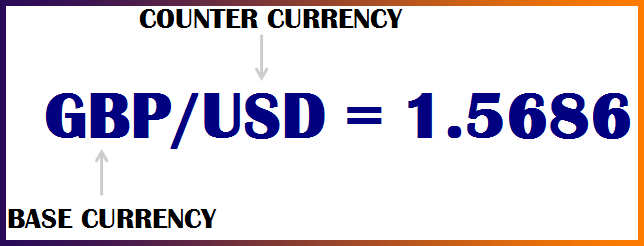What are a Base Currency and Quote Currency?
The first currency to the left of the slash is known as "the base currency" while the currency on the right is known as the quote or counter currency. The base currency is always equal to a value of 1.

As the image above illustrate, the GBP (Great Britain pound) is the base currency while the U.S. dollar is the counter currency. So the quote would be read as: 1 pound is equivalent to 1.5686 U.S. dollars. In other words, if you want to purchase one GBP, you would have to pay 1.5686 U.S. dollars for it. However, if you would want to sell one unit of the base currency, you would receive 1.5686 U.S. dollars for it. In a quote, the position of a currency is strictly determined and standard. For example, the pair Euro and U.S. Dollar is determined to be EUR/USD and never USD/EUR.
Forex Price Notation in Four Decimals
Forex prices are usually quoted to four decimal places. Having a pricing that goes to the fourth decimal place has the following advantages:
-
A reduced difference between the ask and the bid price, which translates in smaller transaction costs;
-
Better liquidity as well as improved execution for the trader;
-
Higher accuracy in price execution.
As for the Japanese yen (JPY), the situation is slightly different when compared to the other currency pairs. Whenever the JPY is in the counter currency, the Forex quote is given in two decimal places instead of four. Usually, a yen pair is given as USD/JPY = 119.33. This means that one U.S. dollar is equivalent to 119.33 Japanese yen.
The Two Types of Forex Quotes
Direct quote.
This is the price of one unit of foreign currency denominated in terms of the national currency. For instance; if you reside in the United States, your domestic currency is the U.S. dollar. Hence, a USD/GBP quote of 0.66 will be a direct quote for you and that means one U.S. dollar can be used to buy 0.66 British pounds.
This is easy and useful for traders that want to easily transfer foreign prices into the currency that is more common for them.
Indirect quote.
An indirect quote is the exact opposite of a direct quote. It is the value of a domestic currency denominated in certain units of the foreign currency. To make it simple, consider the following example of an indirect quote: If you are a European, your local currency is the Euro, and you can see a quote that looks like this: USD/EUR 0.8765.
This means that one U.S. dollar is sold in exchange for 0.8765 Euros. However, this quote would be a direct one for you if you were an American.
Having the knowledge of the types of quotes is very important for cases when you are engaging in foreign trade, or traveling the world. Whenever you are approaching a local or an international currency exchange, you will most probably notice the quotes displayed directly, hence telling you how much local currency can be bought for one unit of your national currency.


